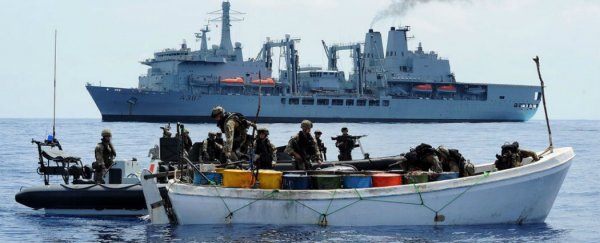Pipe in enough data, and computer algorithms can do just about anything with it - including spotting tell-tale signs of pirate behaviour. The US Navy has just filed a patent application that outlines a "method for predicting pirate attack risk… based on intel regarding pirates", and it might one day help its ships recognise a threat ahead of time.
Despite concerted efforts from the United States and its allies, pirate activity on the high seas continues to be a problem: it's estimated that piracy can cost the US maritime industry up to $16 billion every year. If the Navy can work out a way to minimise part of that threat, the benefits could be huge, and not just for commercial companies: right now, several major charities are sending humanitarian aid around the heavily pirated Horn of Africa region to deal with consequences of violence and loss of income.
The newly proposed system combines information about local weather conditions - as pirates tend to operate in smaller vessels, these can be very important - as well as intelligence data on the pirates themselves. That intel can include previous movements of criminal groups, where their stations are based, the numbers they usually travel in, the speed at which they can move, and where their favourite spots are.
And it's also based on patterns observed in nature. "The model used for the pirate problem is based on a prey/predator game with a learned hunting model for a pirate group as predator," explains the paperwork accompanying the patent. "Unlike prey/predator games where the population oscillates based on evolutionary dynamics, the presence of pirates at sea fluctuates depending on intelligence information as well as current and past meteorological conditions."
Ultimately the computers used to run this software would be able to output a series of hypothetical "pirate replicates" - virtual pirates that should be expected based on past activity, the weather conditions, a particular group's capabilities, and so on. Each "replicate trajectory" would cover travelling from a base to open water, looking for targets, and finally returning to base again. Naval officers are left with a "pirate probability rating" based on their location, the time of day, and the conditions at sea.
What the Navy is proposing makes use of the Monte Carlo method for probability distribution, using a combination of what's happened in the past and random sampling techniques in order to predict what's going to happen next.
Further down the line, these algorithms could be used more widely: the Navy suggests employing them in warfare situations to predict enemy manoeuvres or to catch drug smugglers based on the routes they've historically taken. One of the points made in the patent application is the flexibility of the technology to adapt to different needs, whether or not you're trying to evade a pirate skiff.
